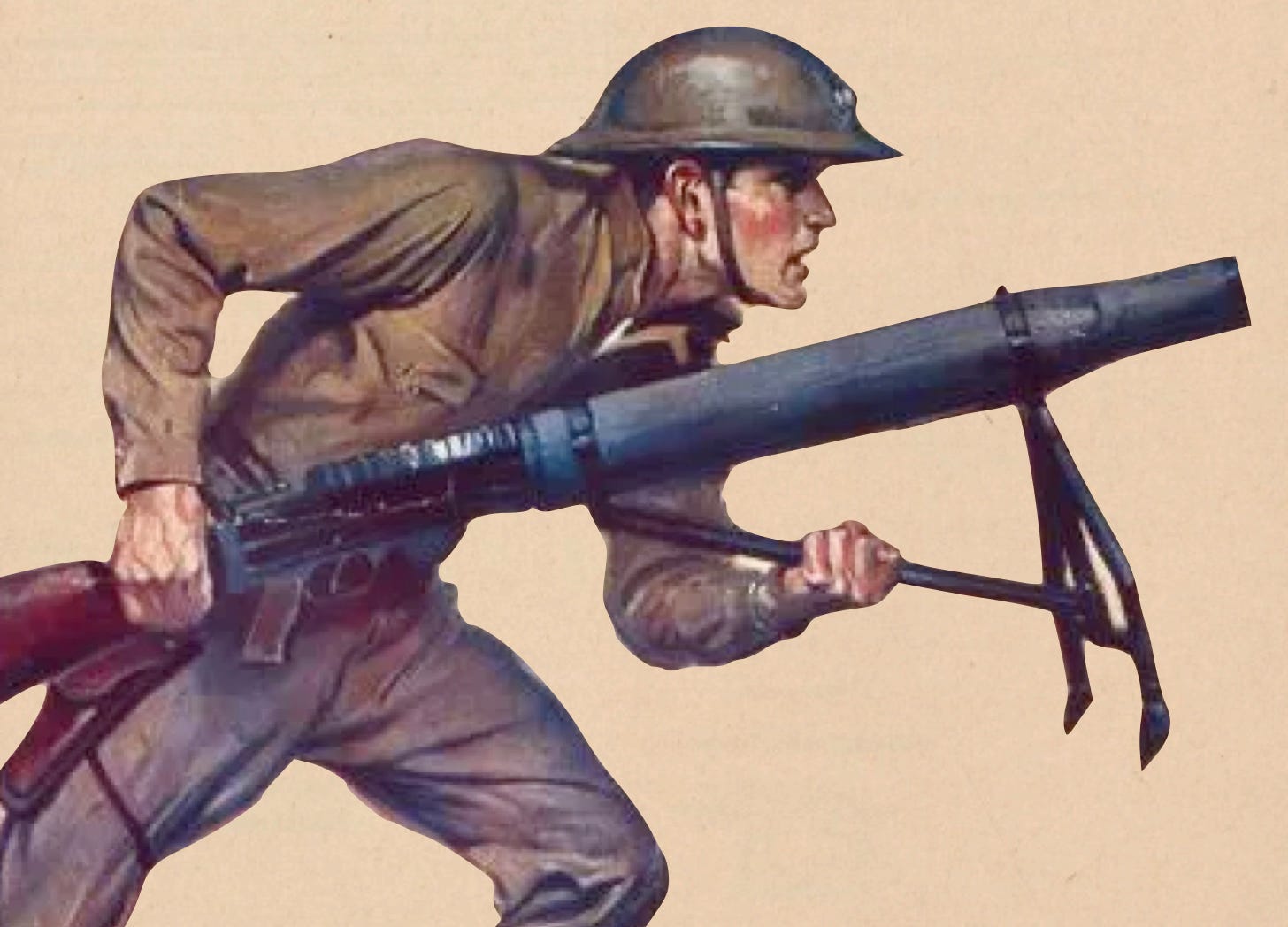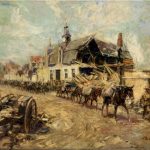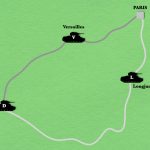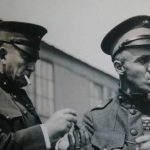The estate of the late John Sayen has graciously given the Tactical Notebook permission to serialize his study of the organizational evolution of American infantry battalions. The author’s preface and previously posted sections of this book may be found via the following links:
The June 1916 National Defense Act, which advanced the Army and the National Guard to their largest peacetime strengths ever, was followed in August by a similar Naval Appropriations Act. The latter authorized the largest Naval shipbuilding program ever undertaken by the United States and increased the Marine Corps’ authorized strength from its 1913 level of 340 officers and 10,000 men to nearly 600 officers and 15,000 men. A further increase to 700 officers and 17,400 men was authorized during the following March. The 1916 Act also authorized the appointment of Marine warrant officers and established small Navy and Marine Corps reserve organizations.
When the United States declared war on Germany on April 6, 1917, the Marines had reached an actual strength of 511 officers (including 43 retired officers on active duty and 49 warrant officers) and 13,211 men. The First Regiment (with seven companies) served as a fixed defense regiment at Philadelphia but was available to assist the Navy in countering a highly improbable German threat to the Panama Canal. The Second Regiment occupied Haiti under the First Provisional Brigade. The Third and Fourth Regiments served in the Dominican Republic under the Second Provisional Brigade. These four regiments would have totaled some 3,300 officers and men and perhaps 35 of the Corps’ 50 to 60 numbered companies. Smaller overseas garrisons totaled about 2,100 officers and men. Another 2,200 men were serving at sea with the fleet and about 6,600 were stationed at various posts in the United States.[1]
The declaration of war presented the Marine Corps Commandant, Major General George Barnett, with a serious problem. Although the Marine Corps had advanced considerably in both size and importance since 1898, its future was still precarious. Lacking any guaranteed existence like the Army and Navy, it had to retain the good will of both Congress and the public. The Marines had always emblazoned their recruiting posters with the slogan “first to fight” but they had always fought as part of the Navy. Any war with Germany was going to be mostly an Army affair and mostly fought in France by the AEF. The Marines would somehow have to find a place for themselves in the AEF in order to make good on their slogan. If they failed they might find themselves facing institutional extinction.
In the past, the Marines had participated in only a few operations with the Army and most of those had been on a very small scale. Nevertheless, General Barnett managed to persuade the Secretary of the Navy, Josephus Daniels, that the President had the authority to transfer all or part of the Marine Corps to the Army in wartime. Barnett also pointed out that this war was going to be fought mainly on land and that if the Corps did not take part it would die. The Secretary, in turn, persuaded the President to sign the necessary Executive Order. General Pershing appears to have been willing, at this point, to allow some Marines to serve as infantry in the AEF but he did insist that they use the same tactical organization and doctrine as the Army. This was entirely acceptable, and Barnett hurriedly organized the Fifth Marine Regiment and sent it to France as an attachment to the AEF 1st Division.
The Fifth Regiment arrived in France in July 1917. Being the fifth regiment of a four-regiment division, it soon found itself relegated to the sidelines and stuck with all the odd jobs such as providing military police details, couriers, and guards. Correctly reasoning that a larger unit would not be so easily pigeonholed, General Barnett in October 1917 augmented the Fifth Regiment with the newly formed Sixth Regiment and Sixth Machinegun Battalion. The whole force constituted the AEF Fourth Brigade, or half the infantry of the AEF 2nd Division.[2]
Although the organization of the Fourth Brigade’s infantry regiments was supposed to be the same as that of all the other AEF infantry regiments, it did in fact differ in some details (see Appendix 2.6). Every Marine rifle and machinegun company had two additional sergeants to serve as gas NCOs and the Marines added gas officers to each battalion headquarters. Whether this helped reduce the number of gas casualties is unclear.
Marine enlisted men also tended to be given higher ranks than their Army counterparts. In a Marine regiment a platoon sergeant was not just the senior sergeant in a platoon, he was a gunnery sergeant, ranking as an Army sergeant first class (a rank that the Army awarded only to specialists) and well above a sergeant. Sergeants commanded all four sections in a Marine rifle platoon and this allowed an additional sergeant per half-platoon. The rifle section included two men trained equipped as snipers (enough for one sniper per half-platoon). Two more snipers were in company headquarters. Since 1887 when test results had exposed their poor marksmanship, the Marines had made rifle shooting into even more of a fetish than it had been in the Army. In contrast to the many soldiers sent into battle without even having fired their rifles, no Marine was even allowed overseas if he had not qualified as an expert rifleman or sharpshooter.
To give extra promotion, pay, and recognition (but not leadership responsibility) to the best shots the Marines introduced the rank of corporal (technical). The rank was also given to mechanics, horseshoers, saddlers, teamsters, and five senior operators in the telephone section of the regimental signal platoon to reward technical proficiency. However, despite their important but difficult and thankless duties, Marine cooks only ranked as privates.
It is of interest to note that in a Marine regiment the headquarters platoon included a regimental pay section. Though they were serving with the AEF, Army division-level pay sections did not pay the Marines. The Marines still received their pay through the Navy and they traditionally handled such matters at the regimental level.
Apart from the regimental-wide changes already mentioned, there were few alterations to the supply company, except in the ranks and titles of some of its personnel. The Marines used quartermaster sergeants rather than regimental supply sergeants and a Marine gunnery sergeant headed the ordnance detachment in lieu of a sergeant. Also, a warrant officer (quartermaster clerk) augmented the supply company headquarters and, in September 1918, another warrant officer (paymaster clerk) augmented the regimental staff. The diagram in Appendix 2.6 shows the Marine regiment, as it would have appeared just before the addition to its supply company of two more lieutenants.
The Navy supplied the regiments’ medical personnel and chaplains. Where the Army allowed 48 medical enlisted men per regiment, the Navy gave the Marines 55. The extra men were certainly needed. The Marine Brigade had the highest casualties of any similarly sized unit in the AEF, suffering some 12,000 killed and wounded besides losses from sickness and accidents. As proof of the Marine Brigade’s high morale it should also be noted that only 25 Marines became prisoners of war, far below average for an AEF brigade. Finally, it should be pointed out that the Army’s Third Infantry Brigade, forming the other half of the 2nd Division’s infantry, sustained the second highest losses of any AEF brigade. Overall, the 2nd Division incurred nearly ten percent of all AEF battle casualties but it captured 12,000 Germans or about 19 percent of all Germans taken prisoner by the AEF. The division played a leading role in most of the AEF’s major battles.[3]
The Marine AEF regiments differed from their Army counterparts in more than just structural details. They had a huge advantage in manpower quality. Except for about 7,100 draftees accepted during the war’s last weeks, the nearly 79,000 Marines who served in the war were all volunteers. About one sixth of these men had joined prior to the war. This was several times the Army’s percentage of pre-war men, even if those who had only National Guard service are included. Many Marine wartime volunteers were college men and included a lot of athletes.
The large number of officer-quality enlisted men persuaded General Barnett to direct on 4 June 1917 that, in future, all officers be appointed from the ranks. This move had the strong backing of Secretary Daniels who favored the practice of commissioning enlisted men. Such a system would be more in line with what the Germans and French were doing. Even the college men would have to have several months’ enlisted service before they could hope for a commission. By then their leadership potential could be properly evaluated. In addition, many pre-war enlisted men of greater age and experience but less education and growth potential could also become officers. Better still, the Marines were mostly infantry. Unlike the Army, they had few service or technical positions into which their best and brightest could be drained. Instead of getting the dregs, Marine infantry regiments got all the best officers and men. They were always kept at full strength with fully trained replacements, despite heavy casualties.[4]
The high quality men that the Marines were able to contribute to the AEF provoked a good deal of jealousy within the Army in general and from General Pershing in particular. The latter praised the Marines in private but refused to do so in public. Although Pershing had accepted the Fourth Marine Brigade into the AEF, he rebuffed every offer to send Marine artillery to France. The presence of both Marine infantry and artillery in France would have paved the way for the formation of a Marine AEF division. That would have given the Marines much more publicity at Army expense.
Late in the war Pershing relented enough to accept another Marine infantry brigade, the Fifth, which reached France in September 1918. However, although nearly all these Marines had qualified as expert marksmen, he employed them in menial jobs in the rear areas. At the same time, Pershing was rushing thousands of untrained Army recruits into front line combat where they were routinely and needlessly slaughtered.[5]
Despite their advantages over the Army and despite the fact they were facing German units who could hardly be called elite, the Marines found the test of battle, especially at such places as Belleau Wood and Blanc Mont, to be a hard one. Until their relief on 18 June 1918, units of the German 237th Infantry Division held most of the sector that the Marines attacked during the fighting at Belleau Wood. This division had only been activated in January 1917. Most of the division’s early service had been relatively easy duty in Russia. It had only been in France since March 1918. Allied intelligence rated it “mediocre.”[6] The division’s three infantry regiments, the 460th, 461st, and 462nd were each supposed to have nearly 3,000 men but, as of June 1918, they had no more than 1,200 apiece. This was equivalent to a single AEF battalion with its attached machinegun company.
Worse, the German’s previous advances had left them far ahead of much of their artillery and with only limited forces with which to launch counterattacks. Thus, two of the important ingredients of previous German defensive successes against the British and French were absent. However, although they were severely depleted in their manpower, the twelve rifle companies, three machinegun companies, and mortar company in each German regiment retained much of their full complement of weapons.
A German rifle company, though not much larger than an AEF platoon, operated six MG-08/15 light machineguns (LMG), a machinegun company had eight MG-08 Maxim guns (of the 12 it was authorized) and a mortar company could still operate six 76mm light trench mortars. However, once the LMG’s in the rifle companies were fully manned, few men were left to serve as riflemen. Hence, the close combat capabilities of these companies tended to be even weaker than their low fighting strengths would suggest. Nevertheless, the German soldiers could count on being led a skilled and combat experienced cadre of officers and NCOs. The Marines had no such advantage and this weakness probably did the most to turn their attack into a bloodbath.[7]
On the morning of 6 June, the 461st Regiment held Belleau Wood itself. The 460th was on their right, with a small detachment holding a forward position on Hill 142. The 462nd was in reserve. The 5th Marines opened the battle by sending a battalion charging across open ground, without any cover from friendly smoke or artillery fire to attack Hill 142, apparently in the belief that the Germans were not occupying the woods beyond. Though the Germans soon retired from their rather exposed position, its capture cost 410 Marine casualties. To win a toehold in the wood and in the ruins of the adjacent town of Bouresches (on the 461st Regiment’s left flank), the Marines launched a second assault that afternoon that was nearly as reckless as the one that morning.
Two reinforced companies from the German 398th Infantry Regiment, 10th Division, held Bouresches. These Germans, helped by the fire of their comrades from the 461st, were able to exact another 1,087 casualties from the three Marine battalions sent against them. By nightfall on 6 June 1918, the Marines had lost more men killed in action than they had ever lost during their entire previous history (since 1775). Subsequently the Marines (with a good deal of coaching from the French) began to put aside their Civil War era tactics and to make better use of cover and of their own considerable superiority in supporting artillery. Marine marksmanship proved very useful for defeating German counterattacks on 13 June. Recently captured positions were always vulnerable to counterattack because the machineguns and other heavy crew served weapons needed to hold on to them could not be brought forward quickly enough. Skill with the rifle could to some degree compensate for this.
Most of the wood and of Bouresches was gradually cleared by 15 June. After that the Army’s 7th Infantry (3rd Division AEF) temporarily relieved the worn out Marines. However, being only a regiment and not a brigade, the 7th Infantry did not attack and instead merely held onto the captured ground. The Marines renewed their attack after they returned to the front on 23 June. Helped by an overwhelming artillery bombardment, they were able to secure the last of the wood (now defended by elements of the German 87th Division, which had recently relieved the battered 237th) on June 26. The Marines had demonstrated that amateurs could win if they are willing to pay the costs of their own ignorance. In their case the cost of this modest success amounted to some 5,000 dead and wounded.[8] Speaking of the AEF as a whole, one contemporary summarized its tactics as “overwhelming German machineguns with American flesh.”[9]

Editor’s Note: The format of the many appendices to this work fit poorly with Substack. For that reason, I have placed them on a PDF file that can be found at Military Learning Library, a website that I maintain.
[1] Major Edwin N. McClellan USMC, The United States Marine Corps in the World War (Washington DC, USPO, 1920; reprinted 1968) pp. 11-17; Major John H. Johnston USMC, A Brief History of the First Marines (Washington DC, Historical Div. HQMC; revised version 1962) pp. 11-12; Captain Robert J. Kane USMC, A Brief History of the Second Marines (Washington DC, Historical Div. HQMC; revised version 1964) pp. 9-11; Benis M. Frank, A Brief History of the Third Marines (Washington DC, Historical Div. HQMC; revised version 1968) pp. 3-4; James S. Santelli., A Brief History of the 4th Marines (Washington DC, Historical Div. HQMC; 1970) pp. 9-10; and Heinl op cit pp. 186-187.
[2] Major David N. Buckner USMC, A Brief History of the Tenth Marines (Washington DC, Historical Div. HQMC; 1981) pp. 16-17.
[3] Tables of Organization Numbers 1 (infantry regiment) dtd 1 August 1918 and 5 (rifle company) dtd 1 September 1918. Copies of both are at the Marine Corps Historical Center at the Washington Navy Yard, Washington DC; ”Report of the Secretary of War” for fiscal year 1925-26 (Washington DC. US Government Printing Office 1926) p 210; and Heinl op cit pp. 219 and 250.
[4] Heinl pp. 191-228; and J. Robert Moskin, The Story of the U.S. Marine Corps (New York, Paddington Press Ltd. 1979) pp. 138-139; LtGen William K. Jones USMC(Ret) A Brief History of the 6th Marines (Washington DC, History and Museum Div. HQMC 1987) p 1.
[5] Heinl pp. 194-195 and 208-210; Allan R. Millett, Bullard op cit p. 321.
[6] According to Allied intelligence, which tended to paint a rosier picture than was wise, the division was initially composed of still-convalescing veterans and raw recruits. The Allies also perceived an incident in April 1918 in which members of the division, encouraged by their officers, openly fraternized with the French as a sign of weakness. The Allies had much more justification in seeing another incident in August 1918, wherein 80 armed members of the division surrendered to only four French soldiers as indicative of low morale (more than 900 members of the 237th Division were taken prisoner in that month) but after the failure of the 1918 offensives and the cumulative effects of casualties and the blockade German morale was already close to the breaking point and would soon collapse altogether.
[7] Heinl op cit pp. 200-203; Moskin op cit pp. 112-124; Jones, 6th Marines op cit pp. 6-12; War Department, Office of the Adjutant General, German Divisions Which Participated in the War (Washington DC, US Government Printing Office 1920) pp. 181-183, 378-381, 563-565, and 729-730. However, Mosier op cit on p. 173 casts a good deal of doubt on the reliability of this source, pointing out that the British and French intelligence services that provided most of the data could not draw a line between propaganda and intelligence and actually altered German order of battle data to cover up their own blunders. However, the 237th was certainly not an elite unit and German morale at this stage of the war was falling. See also James W. Rainey “Ambivalent Warfare” Parameters September 1983 op cit p. 44. For the German side of Belleau Wood the standard work is Ernst Otto, Under dem Stahlhelm, Einzelchriften aus dem Weltkrieg, Vol. I (Berlin, Wilhelm Rolf, 1930) pp. 1-39.
[8] The 5,000 American casualties at Belleau Wood included both Marines and supporting Army and Navy personnel. John Mosier (p. 326) has noted that the American Cemetery at Belleau Wood contains 2,289 single graves and commemorates 1,060 missing, the highest of any American military cemetery from this war. Given the usual proportion of wounded this suggests that actual American losses may have been significantly higher than officially reported. According to Ernst Otto the German 237th Division’s casualties on 6 June amounted to 78 killed in action (KIA), 228 wounded in action (WIA), and 95 missing in action (MIA). The German 10th Division lost 24 KIA, 101 WIA, and 26 MIA. Although the 237th Division was mainly fighting the Marine Brigade that day the 10th Division (relieved a few days later by the 28th Division) mainly engaged the 3rd Brigade though it fought elements of the 4th. From 6 June until its relief on 18 June the German 237th Division sustained 309 KIA, 1,078 WIA, and 327 MIA. This suggests that total German losses in and around Belleau Wood through 26 June were about 2,000 to 2,500. For his defense of Belleau Wood, the commander of the 461st Regiment, Major Bischoff, received the Pour le Mérite (Blue Max), one of Germany’s highest military decorations.
[9] Ibid and Millett, Bullard p. 315 op cit





